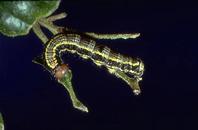Recently Susan, myself and our running friends have noticed two things as we run the trails through the coastal scrub oak of our decommissioned military base here in Monterey, California: All the oak trees are bare, and little caterpillars are crawling all over our running clothes.
They are the California oak worm (Phryganidia californica). They are always around, but every five or ten years they have an outbreak like this one, and absolutely devastate the local oak forests. It’s scary—the trees all look like skeletons. It would seem there’s nothing left to photosynthesize with. You honestly wonder if they’re going to survive. The first time I witnessed one of these episodes I asked my elderly neighbor in some alarm whether the trees were going to die. He gazed up with me at the sky, through what used to be our oak canopy, and said, “Aw, you can’t kill an oak tree.” The dear fellow passed away many years ago, and so far he has not been proven wrong.
The outbreaks actually have nothing to do with the oak trees. It usually happens because one of the oak worm’s predators is having a bad year. Or it might be that both the oak worm and the predators had a bad year last year, and the worms bounce back faster, resulting in a crazy period like this while the predators catch up. The thing about the balance of nature is that it may be a balance, but it’s not a stasis. It is constantly in motion, and oaks and oak worms have been going through cycles like this for hundreds of thousands of years.
A healthy oak tree can survive a complete defoliation—even two or three of them in a row. (And the oak worms, obligingly, can supply it—their life cycle has two to three generations per year.) But the oaks don’t have to like it—it really does sap their reserves, and opens them up to secondary pests that attack weakened trees. But one cute irony that inserts a little balance into the boom is that a weakened tree actually gets attacked less by worms, because the leaves are tougher and more dried up and less nutritious. My friend Venu was commenting that two trees right next to each can look very different—one will be a skeleton, and right next to it will be a fairly healthy-looking tree. We were wondering if maybe they were different species, and some species don’t get attacked. But no, according to my reading they all do—anything in the genus Quercus is fair game.
But my neighbor had it right, oak trees are tough. It’s estimated that they are host to 850 insects and 380 diseases, and most of them are present most of the time. When you look at a serene, peaceful oak tree—or any number of other serene, peaceful things in nature—you’re looking at a pitched battle. You can’t hear the clarion calls or see the caissons, but believe me, it’s war. As long as all the combatants evolved together and know each others’ tricks, no one gets the permanent upper hand. They all, in a sense, get along.
Now you know.

